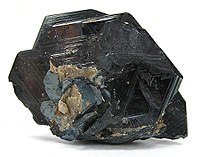
Photo from wikipedia
Abstract This article investigates the activity of TiO2-rutile and TiO2-anatase polymorphs in the catalytic HBr oxidation, which is an enabling process to close the halogen loop in bromine-mediated transformation of… Click to show full abstract
Abstract This article investigates the activity of TiO2-rutile and TiO2-anatase polymorphs in the catalytic HBr oxidation, which is an enabling process to close the halogen loop in bromine-mediated transformation of natural gas to high-value chemicals and liquid fuels. The evaluation of rutile-, anatase-, and rutile-anatase TiO2 catalysts, exhibiting the variable specific surface areas, revealed that anatase phase is also active in this reaction. Nonetheless, in contrast to photocatalytic processes in which anatase is typically more active than rutile, rutile exhibits ca. 2–5 times higher intrinsic rates of HBr oxidation than anatase. Thereby, the apparent activation energies and reaction orders with respect to HBr, O2, and H2O display similar values for the two polymorphs. The activity differences were rationalized by density functional theory analysis, which showed that HBr oxidation follows a similar defect-driven mechanism over the most stable rutile (110) and anatase (101) surfaces. Herein, HBr activates the catalyst through a self-doping mechanism that involves the substitution of surface oxygen by bromine with the concomitant reduction of Ti4+ to Ti3+ centers. This forms a defect level that is placed in the band gap and allows for the O2 activation on the catalyst surface. While the HBr adsorption and H2O desorption display a similar energy profiles on both polymorphs, the O2 activation and Br2 evolution are more facile over rutile compared to anatase surface due to shorter distances between the coordinatively unsaturated Ticus sites and easier reduction of Ti4+ centers upon product desorption, respectively.
Journal Title: Catalysis Today
Year Published: 2020
Link to full text (if available)
Share on Social Media: Sign Up to like & get
recommendations!